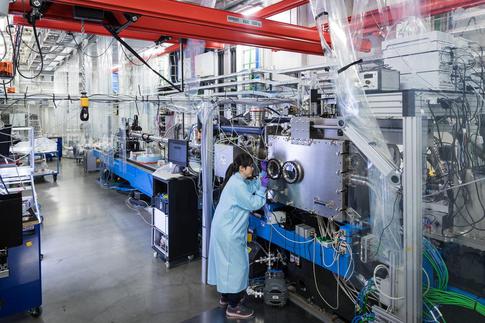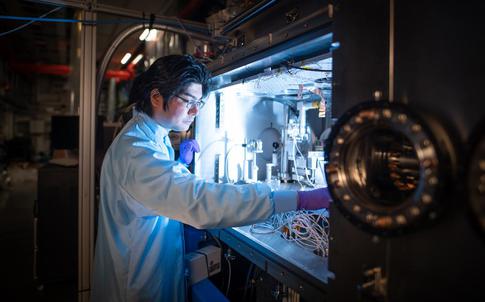XFEL: First European XFEL research results published
First European XFEL research results published

The SPB/SFX instrument at European XFEL. Copyright: European XFEL
Just days before the first anniversary of the start of European XFEL user operation, the first results based on research performed at the facility have been published. In the journal Nature Communications, the scientists, headed by Prof. Ilme Schlichting from Max-Planck-Institute for Medical Research in Heidelberg, Germany, together with colleagues from Rutgers State University of New Jersey, USA, France, DESY and European XFEL, describe their work using the intense X-ray laser beam to determine the 3D structure of several proteins. They demonstrate, for the first time that, under the conditions used at the time of the experiment an increased number of X-ray pulses per second as produced by the European XFEL can be successfully used to determine the structure of biomolecules. As much faster data collection is therefore possible, the time needed for an experiment could be significantly shortened. The detailed determination of the 3D structure of biomolecules is crucial for providing insights into informing the development of novel drugs to treat diseases.
Prof. Ilme Schlichting said: “Our work shows that under the conditions used data can be collected at European XFEL at a rate much faster than has ever been previously possible. As the time and cost of experiments decrease, very soon many more researchers will be able to perform experiments at high repetition rate X-ray lasers. Our results are therefore of interest not only tor the fields of biology and medicine, but also physics, chemistry and other disciplines.”
Prof. Robert Feidenhans’l, managing director of European XFEL: “This fantastic result, published just weeks after the experiment itself, is a reflection of the hard work of many dedicated people. Our users as well as our staff at European XFEL, DESY and our collaborators have all ensured that everything from designing and setting up the experiment, through to data collection and publication works effectively.”
The scientists studied a mixture of three plant proteins – an enzyme known as urease, concanavalin A, and concanavalin B. At the SPB/SFX instrument (single particles, clusters and biomolecules /serial femtosecond crystallography), a jet of liquid containing a stream of tiny protein crystals was injected into the interaction chamber. The X-ray beam, consisting of series of ultra-short X-ray pulses, was fired at the jet, hitting the crystals. Where X-ray pulses interacted with the crystals, so-called diffraction patterns were captured by the detector situated behind the interaction chamber. With the help of computer algorithms, these images can be used to construct 3D models of the proteins being studied. The scientists were able to collect many thousands of images which were good enough to be able to distinguish between the three proteins, and construct 3D models of the concanavalin A and B proteins. (see also info box 'experimental challenges')
Experimental challenges When hit by the first pulse of the pulse train, the liquid jet delivering the sample is momentarily blown apart. It was, therefore, feared that the time between the pulses (less than a millionth of a second) would be too short for the jet to recover in time for the next pulse. Another worry was that the first pulse would produce a shockwave, that would travel along the liquid jet with such a force as to affect the crystals before they even entered the X-ray beam. This would therefore prevent subsequent pulses from measuring anything useful. Both of these fears have however been proven to be unfounded for the experimental conditions of this study, demonstrating that the European XFEL can be used at this very high pulse rate. |

Guest scientist Tokushi Sato working at the sample chamber of the SPB/SFX instrument. Copyright: European XFEL
The X-ray laser can generate up to 27 000 pulses per second. However, the X-ray pulses of the European XFEL X-ray beam are organized into short bursts which are separated by longer pauses with no pulses at all. If a burst lasted an entire second, it would deliver more than a million pulses – or 1.1 megahertz. Now, for the first time ever – such a rate of over one million pulses per second, or one megahertz has been reached. No other X-ray facility worldwide currently can provide such a high rate. (see also info box 'pulse rates explained')
Pulse rates explained At the time this experiment was carried out, European XFEL was generating 500 pulses per second. But the pulses generated by the X-ray laser are not evenly distributed and spaced throughout time. Instead they are concentrated in ten short bursts per second, known as pulse trains. The ten pulse trains with 50 pulses each are separated by a break where no pulses are delivered. Hence the 50 pulses are actually delivered within a much shorter time frame than one second. Within each pulse train, the individual pulses are extremely close together. If the pulse train lasted an entire second, it would therefore deliver more than a million pulses – or 1.1 megahertz. This is the pulse rate. Eventually European XFEL will provide 27 000 pulses a second, at a rate of more than 4 Megahertz. |
Dr. Adrian Mancuso, leading scientist at the SPB/ SFX instrument: “This milestone is the fruit of a lot of hard work by the SPB/SFX team and all European XFEL staff, as well as all of our early users–from more than 35 universities and labs around the world–who assisted with commissioning the SPB/SFX instrument. With these results we could now, for example, use these pulses to produce movies of molecules in motion. If we can kick start a reaction during the first few pulses of a train, we can then use the rest of the pulses to take snapshots of that reaction as it unfolds.”
Currently only five X-ray lasers world-wide produce X-rays with a short wavelength, so-called hard X-rays. Access for experiments is therefore in high demand, and the facilities are generally highly oversubscribed. Shortened experiment time thanks to an increased number of X-ray pulses as described today will enable more and more complex research projects and allow a larger number of scientists access to the brightest X-ray sources in the world.
Acknowledgement: The SFX User Consortium has provided instrumentation and personnel that has enabled this experiment. The SFX User consortium is composed of scientific partners from Germany, Sweden, the United Kingdom, Slovakia, Switzerland, Australia and the United States.
Original article: Nature Communications, Grünbein et al., Nat. Comm., 2018
doi: 10.1038/s41467-018-05953-4
